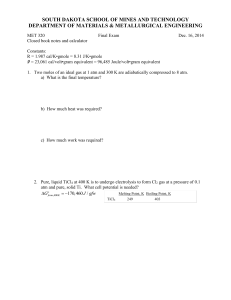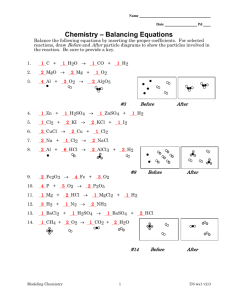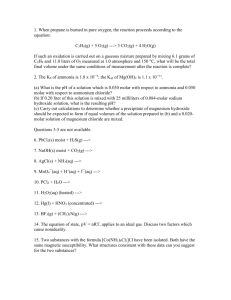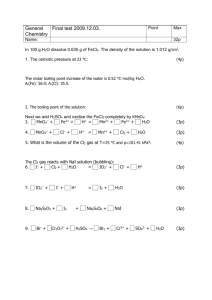File
advertisement
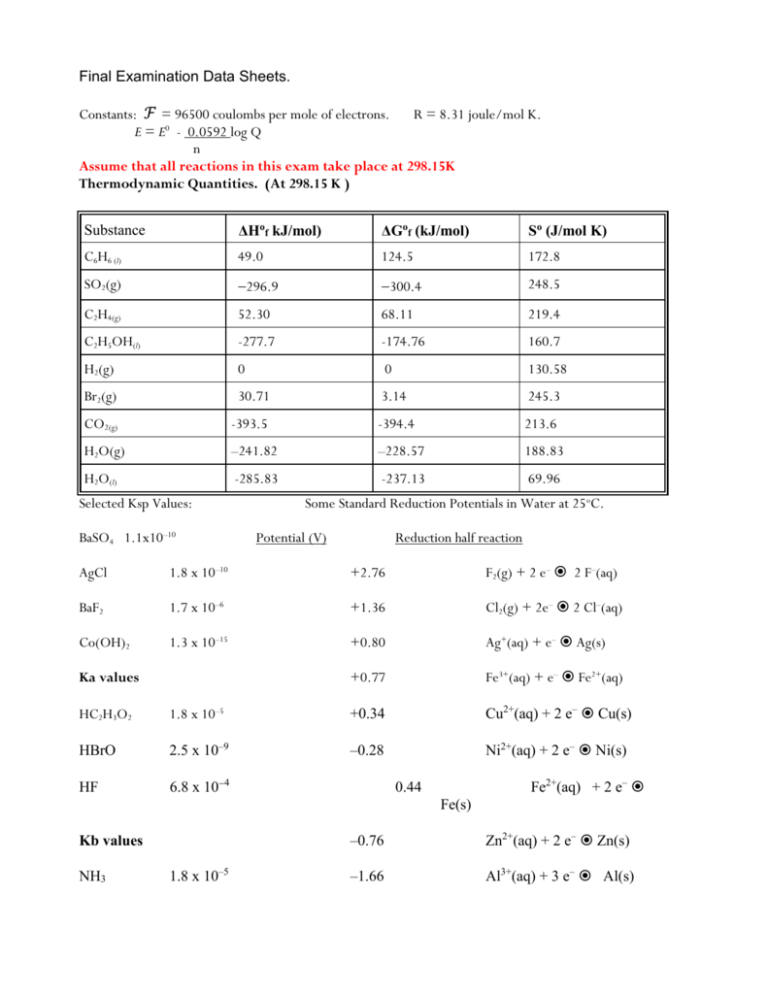
Final Examination Data Sheets. Constants: ℱ = 96500 coulombs per mole of electrons. R = 8.31 joule/mol K. 0 E = E - 0.0592 log Q n Assume that all reactions in this exam take place at 298.15K Thermodynamic Quantities. (At 298.15 K ) Substance ΔHof kJ/mol) ΔGof (kJ/mol) So (J/mol K) C6H6 (l) 49.0 124.5 172.8 SO2(g) 296.9 300.4 248.5 C2H4(g) 52.30 68.11 219.4 C2H5OH(l) -277.7 -174.76 160.7 H2(g) 0 0 130.58 Br2(g) 30.71 3.14 245.3 CO2(g) -393.5 -394.4 213.6 H2O(g) –241.82 –228.57 188.83 H2O(l) -285.83 -237.13 69.96 Selected Ksp Values: BaSO4 1.1x10–10 Some Standard Reduction Potentials in Water at 25oC. Potential (V) Reduction half reaction AgCl 1.8 x 10–10 +2.76 F2(g) + 2 e– 2 F–(aq) BaF2 1.7 x 10–6 +1.36 Cl2(g) + 2e– 2 Cl–(aq) Co(OH)2 1.3 x 10–15 +0.80 Ag+(aq) + e– Ag(s) +0.77 Fe3+(aq) + e– Fe2+(aq) Ka values HC2H3O2 1.8 x 10–5 +0.34 Cu2+(aq) + 2 e– Cu(s) HBrO 2.5 x 10–9 –0.28 Ni2+(aq) + 2 e– Ni(s) HF 6.8 x 104 Fe2+(aq) + 2 e– 0.44 Fe(s) Kb values NH3 1.8 x 10–5 –0.76 Zn2+(aq) + 2 e– Zn(s) –1.66 Al3+(aq) + 3 e– Al(s) HONH2 1.1 x 10–8 BROOKLYN COLLEGE CHEMISTRY DEPARTMENT Final examination in chemistry 2 Name___________________August 18, 2009 Questions 1 - 7 are based on the following chemical system: 1.25 pts each except as noted. For the reaction of SO2 gas with O2 gas, 2 SO2(g) + O2(g) ⇄ 2 SO3(g), ΔH° = 196.6 kJ at 298 K Predict the effect of each of the following changes on the equilibrium quantity of O 2(g) (Increased, decreased, or unchanged) (I, D, or U) __D____1. Temperature is decreased ___D___2. Container volume is decreased ___I___3. Some SO2 is removed from the system ___U___4. A catalyst is added to the equilibrium system ___-395.2 kJ_______5. Using the given ΔH for the reaction, and the information on your data sheets, find ΔH ̊f of SO3(g). _-190J/molK__or 0.190 kJ/molK 6. ΔG° for the reaction above is 140 kJ/mol at 298 K. Find ΔS° for the reaction at that temperature. (-.5 if unit is wrong or omitted) ___C_______7. Based on the value of ΔG° we could conclude that the value of the equilibrium constant K for the reaction is A) negative B) positive, and less than one C) positive, and greater than one D) no prediction can be made about the magnitude of K At high temperatures, the solid NH4Cl decomposes to form NH3 and HCl gases NH4Cl(s) NH3(g) + HCl(g) __81____________8. A sample of NH4Cl is heated until, at equilibrium, pNH3 is 9.00 atm. What is Kp for the reaction at that temperature? __0.0156____________9. At a certain high temperature, with the reaction N 2(g) + 3 H2(g) 2 NH3(g) at equilibrium, it is found that the pressure of each of the three gases is 8.00 atm. What is the value of the Kp for the reaction at that temperature? 7.2___________10. Suppose that in the reaction 2 SO2(g) + O2(g) 2 SO3(g), the initial pressures of the SO2(g) and O2(g) are each 2.00 atm. At equilibrium, at the same temperature, the pressure of the SO3 is found to be 1.50 atm. What is the value of Keq at that temperature? _D____11. Which of the following acids has the weakest conjugate base? A) HF B) HC2H3O2 C) HBrO D) HNO3 ___1.085________12. What is the pH of 0.0823 molar HCl ? (-.5 for 1.0 or 1.1) A chemist prepares three aqueous solutions; their properties are summarized in the table below. Solution A is dilute HCl. Solution B is dilute NH3 Solution C is a solution of a weak acid, but he can't remember which. He has a pH meter, but it is accurate only for pH values of less than 7. Here is his data: Solute HCl NH3 ?? Solution A ? molar B 0.200 molar C 0.200 molar pH 1.90 ?? 3.12 0.013___________13. What is the molarity of the HCl solution? full credit for 0.0126 or 0.012 __11.278_________14. What is the pH of the NH3 solution? accept 11.3, or 11.28, -1 pt for 11 ___2.9 x 10-6_______________15. What is the Ka of the acid in solution C? __D_________16. What is the molar solubility of BaF2 ? A) 1.7 x10–6 M B) 1.19 10–2 M C) 1.3 x 10–4 M D) 7.5 x10–3 M _8.1 x 10-8____17. If the Co2+ concentration is 0.200 molar, what is the minimum [OH] needed for a precipitate of Co(OH)2 to form? __6.91_________18. What is the pH of the solution in question 17 ? _A________19. Which metal reacts spontaneously with Fe2+(aq) ? A) Al B) Ag C) Cl2 D) Ni __A_______20. In the electrolysis of molten NaCl(aq) with inert electrodes, which process occurs at the negative pole ? A) sodium ions are reduced to sodium metal. B) chloride ions are reduced to chlorine gas C) chloride ions are oxidized to Cl2 gas D) sodium atoms are oxidized to sodium ions ____1.08 v_____21. Find ℰ ° for the reaction Ni(s) + 2Ag+ (aq) Ni2+(aq) + 2Ag(s) ___2______22. What is the charge on the ion with the name tetrachloroferrate (II) ? __4_______ 23. What is the coordination number of the metal ion called bis(ethylenediamine)nickel(II) ? _11_________24. How many carbons are there in the molecule with the name 3–ethyl,2,2–dimethylheptane? ___12_______25. How many hydrogen atoms are there on the molecule called 2-methyl butane? Indicate the hybridization (sp3,sp2, sp, sp3d2, sp3d) for each of the following atoms: __sp2________26. The carbon in a molecule of methanal. (formaldehyde) __sp________27. The middle carbon atom in 2-pentyne ____sp3______28. The carbon in a molecule of methanol ___sp3d_______29. The sulfur on a molecule of SF4 ____ sp2__________30. The middle carbon atom in propanone __0.34 v_______31. What is ℰ ̊ for the reaction Cu(s) + 2 H+(aq) Cu2+ (aq) + H2(g) __80.0g_______32. In the electrolysis of molten CaCl2, how many grams of Ca(s) can be produced using a current of 40.00 ampere for 9650 seconds? _B________33. A voltaic cell is constructed using Nickel metal in a 1.0 molar solution of Ni 2+ ions at one pole, and Aluminum metal, in a 1.0 molar solution of Al 3+ ions at the other. The electron flow in such a cell would be A) from Ni to Al B) from Al to Ni C) from Al to Al3+ D) from Ni2+ to Ni __6_______34. A chemist wishes to use the equation ΔG° = nFℰ ° to calculate the value of ΔG° for the reaction 2 Al + 3 Ni2+ 2 Al3+ + 3 Ni . What value should be used for the term "n" in the equation ? ___B______35. In the reaction 2Fe2+ (aq) + Cl2(aq) 2 Cl–(aq) + 2 Fe3+(aq) the oxidizing agent is the A) Fe B) Cl2 C) Fe2+ D) Cl___+6_____36. What is the oxidation state of the sulfur in the sulfate ion, SO 42– ? 37. Assume that the reaction 2 H2O2 2 H2O + O2 is first order. Determine for each of the following statements, whether the statement is true or false. ( 1 pt each) i. the reaction proceeds at a constant rate __F______________ ii. the reaction has a constant half life if the temperature is constant ______T__ iii. a graph of Ln[H2O2] versus time produces a straight line. _____T________ _4.44_________38. A buffer is prepared by mixing 2.00 moles of HC 2H3O2 with 1.00 mole of NaC2H3O2 in a total volume of 1.00 liter. What is the pH of this buffer? _____4.05_____39. What is the pH of the solution prepared in question 43 after the addition of 100. mL of 5.00 molar HCl ? (accept 4.04, 4.045, 4.0 or 4.1) ___B_____40. When 2.00 molar HCl is titrated with 1.00 molar NH3, the pH at the equivalence point is closest to A) 4.6 B) 7 C) 9.6 D) 12 ____B___41. When 2.00 molar HCl is titrated with 1.00 molar NH 3 the concentration of Cl ion at the equivalence point is A) 1.20 M B) 0.667 M C) .500 M D) 5.00 M ____A______42 Which of the following salts, in aqueous solution, will have the highest pH? A) 1 M NaBrO B) 1 M Al(NO3)3 C) 1 M CuSO4 D)1 M KCl __1.5x1011____________43. What is the Kb of a fluoride ion, F ? __B_________44. Suppose that the decomposition of gaseous substance X is first order. If the initial pressure of X is 4.00 atm, and the pressure after 15.0 seconds is 1.00 atm, what is the rate constant for the decomposition? (sec-1) A) 0.0462 B) 0.092 C) 0.20 D) 0.075 __A____45. The rate constant of the exothermic reaction N2(g) + 3 H2(g) 2 NH3(g) can be increased by increasing the temperature B) increasing the hydrogen concentration C) Decreasing the size of the reaction vessel D) all of these Organic: Use the list of substances, A through H. (questions 46 to 51) A. 2 -pentanol B. 3–ethyloctane D. Pentanal E. 2 - pentyne C. pentanoic acid F. butyl ethanoate G. Hexane _F______46. Which of these substances is an isomer of hexanoic acid? _F______47. Which is formed by the reaction of acetic acid with an alcohol? _E______48. Which of these substances has the fewest hydrogens? _E______49. Which is an isomer of 1,3-pentadiene? ( hint: diene means two double bonds) __B_____50. Which of the following molecules is an isomer of substance B? A) 2-methyl octane B) 2,2-dimethyloctane C) 3,4-dimethyl decane __C_____51. None of these molecules are A) esters D) saturated hydrocarbons B) alcohols C) ethers D) 2-octene A) 52. to 54. The reaction (all gases) 2 NO + 2 H2 N2 + 2 H2O is found to obey the rate law: Rate = k[NO]2[H2]. It is found that at 300 K, when the intitial concentrations of NO and H2 are both 2.00 molar, the initial rate of formation of N2 is 2.00 x 102 M/sec. _0.00250 M-2/sec_52. What is the rate constant of the reaction at 300 K? Include the correct unit. ( -.5 for incorrect unit) _0.16__________53. What is the initial rate of reaction if the H 2 is initially 1.00 molar, while the NO is 8.00 molar ? (in M/sec) A) 4.00 x 102 B) 8.00 x 102 C) 0.16 D) 4.00 x 103 Suppose the following mechanisms are suggested for this reaction: Mechanism I: step 1. step 2. step 3. 2 NO N2O2 (fast, equilibrium) N2O2 + H2 H2O + N2O (slow, rate determining) H2 + N2O H2O + N2 (fast) Mechanism II. step 1. NO + H2 H2O + N (fast, equilibrium) step 2. N + NO N2O ( slow, rate determining) step 3. H2 + N2O H2O + N2 (fast) Mechanism III. step 1. 2 H2 + NO NH4 O ( fast, equilibrium) step 2. NH4O + NO N2 + 2 H2O (slow) _A_____54. Which of these mechanisms is/are consistent with the given rate law? A) I only B) I and II only C) II and III only D) all of them __C_____55. Which molecule contains only σ bonds? A) butanone C) 2-methyl,2-butanol D) ethyl methanoate B) propene _A_______56. What is the expected product of the reaction between Cl2 gas and 1-butene? A) 1,2-dichlorobutane B) 1,1--dichlorobutane C) 2,3-dichlorobutane D) 1,3--dichlorobutane _A______57. The formation of PbCl2(s) , Pb(s) + Cl2(g) PbCl2(s) , is spontaneous at room temperature. At temperatures above 2370 K, the reverse reaction becomes theoretically spontaneous. From this information, we can tell that for the formation of lead(II) chloride, A) ΔH and ΔS are both - B) ΔH and ΔS are both + C) ΔH is while ΔS is D) ΔH is +, while ΔS is Extra Credit (2 pts). If the absolute value of ΔH for the reaction above is 359 kJ/mol, what is ΔS for the reaction? (You must include the correct sign for the entropy change. I gave an absolute value so as not to "give away" question 62) _-151.4 J/molK__________________________ The following is a possible mechanism for the decomposition of ozone, O 3 1. Cl2(g) + O3(g) Cl2O(g) + O2(g) (slow) 2. Cl2O(g) + O3(g) Cl2(g) + 2 O2 (g)(fast) _B_______58 The best description of the Cl2(g) in this reaction is A) intermediate B) catalyst C) reactant D) product. __________Rate = k[Cl2][O3]__59. Write the rate law, based on the mechanism above. _0.25 atm______60. Assume that at a certain temperature the decomposition of iodine vapor, I2(g) 2 I(g) is first order with a half life of 8 minutes. If the initial pressure of the I 2(g) is 4.00 atm., what is the pressure of the I2(g) after 32 minutes? ___HSO4-______________61. What is the formula for the conjugate acid of a sulfate ion? _____B____________62. A ligand can be best described as A) an Arrhenius acid B) a Lewis base C) a Bronsted acid D) an electron pair receiver I. Draw a diagram that clearly shows the difference between cis tetraaquadichloroiron (III) ion, and trans tetraaquadichloroiron(III) ion (4 pts) B. Both of the ions above are high spin complexes. How many unpaired electrons are there on the iron (III) ions? (1 pt) 5 C. The hexacyanoferrate (II) complex is a low spin complex. How many unpaired electrons are there on the iron (II) ion? (1 pt) 0 II. Draw and name three different substances that have the formula C3H8O. (6 pts) III. Draw the structures of the following molecules. You must show all hydrogen atoms. (8 pts) A. butanoic acid B. 2 - pentanol C. 2,3-dichloro,2-butene. D. ethyl butanoate E. Which of these molecules contains a chiral (optically active) carbon? Explain. (2) 2-pentanol. The second carbon has four different attachments. F. Which of these molecules would demonstrate cis-trans isomerism? Explain. (2) 2,3-dichloro,2-butene. There is no free rotation about the double bond, so the chlorines can be either opposite or adjacent. Extra Credits 1 point: Who "dreamed up" the structure of benzene? Kekule 2 points. Write the balanced net ionic equation for the reaction that occurs when an acidified solution of potassium permanganate is added to a solution of oxalic acid. 2 MnO4 + 5 H2C2O4 + 6 H+ 2 Mn2+ + 10 CO2 + 8 H2O


